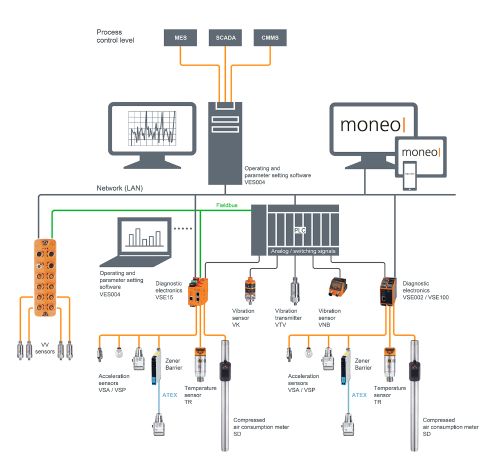- Real-time maintenance
- Vibration
Vibration
What if your equipment could provide alarms before it fails? The detection and integrated evaluation of vibration signals serves as the basis for the seamless integration of online condition monitoring and real-time maintenance into automation and control systems.
- Eliminate unplanned downtime due to equipment failures.
- Monitor key machine condition indicators to predict and plan maintenance activities.
- Implement advanced real-time vibration monitoring without the complexity of traditional systems.
- Integrate easily into your process systems.
Systems for vibration monitoring -- from sensor to ERP (Enterprise Resource Planning)
ifm provides a wide range of vibration solutions from simple switches to fully programmable systems aimed at improving your machine uptime and overall profitability.
Which solution below best describes your application or machine? Click on the desired platform to learn more.
| Vibration sensor platform | |||||
| Application | Machines | VN | VV | VSE | |
|
Type 1 machines |
Simple motors and fans | ++ | ++ | +++ | |
|
Type 1 machines |
Indirect driven fans and pumps | ++ | +++ | + | |
|
Type 1 / Type 2 machines |
Blowers and simple speed reducers | ++ | +++ | ||
|
Type 3 machines |
Centrifugal compressors and machine tools | + | +++ | ||
Vibration behavior and excitation
To understand the best applicaton solution, we must differentiate the forces that cause vibration and excitation.
- Construction-based excitation (C-forces) -- defined by the construction and geometry of the machine.
- Process-based excitation (P-forces) -- caused by dynamic forces of the running process
- Failure-based excitation (F-forces) -- occur when a machine component no longer performs its intended purpose
Construction-based forces
- Predefined by the construction and geometry of the machine
- External sources excite the machine's construction, amplifying the excitation frequency
- C-forces are always present, but controlled in properly operating machines
- Examples
- Unbalance
- Gear mesh
- Fan / pump blade pass
- Motor rotor / commutator pass
Process-based forces
- Dynamic forces resulting from a process
- Occur from the work the machine is performing
- Vibration is only high while the work is performed
- Baseline must be established while the machine is idling
- Examples
- Forming
- Cutting
- Grinding
- Moving
- Separating
Fault-based forces
- Occur when a machine component no longer performs its intended purpose
- Usually lower in amplitude than P-forces
- Caused by a fault or failure
- Examples
- Misalignment
- Damaged bearing
- Looseness or excessive clearance
- Damaged belts
- Cavitation
Type 1 machines
- Simple machines normally running at constant speed
- C-forces occur at low levels
- Fault-based changes are easily monitored during operation
- P-forces are low and do not have an influence
| Examples | C-forces | P-forces | F-forces |
|---|---|---|---|
| Pumps | Unbalance | Flow noise | Bearing damage, alignment, cavitation |
| Motors | Unbalance | Electric fields | Bearing damage, alignment, coupling |
| Blowers | Unbalance | Flow noise | Bearing damage, alignment, stripping, belt resonance |
Type 2 machines
- Simple machines with high process forces
- Clear P-force dominance with a low C-forces
- Fault-based vibrations are lower than process-based vibrations
- P-forces depend on the type and step of the process
- Machine operator can influence the process and create overloading
- Operating excessive P-forces will reduce machine lifetime
- Determination of F-forces is only possible in a reference run during machine idle
| Examples | C-forces | P-forces | F-forces |
|---|---|---|---|
| Simple machine tool | Unbalance | Cutting forces | Bearing damage |
| Hammer mills | Unbalance, couplings | Striking forces | Bearing damage, alignment |
| Shredders | Unbalance, couplings | Cutting forces | Bearing damage, alignment |
Type 3 machines
- Complex machines
- Continuously high C- and P-forces during machining and in idling modes
- Fault-based vibrations are significantly lower than process-based vibrations
- Simple strategies (e.g. reference run) do not work here
- Diagnosis algoritms are required to detect F-forces
- High frequency-resolution and narrow bands
- Separation of carrier and interference frequencies by appying H-FFT filter
| Examples | C-forces | P-forces | F-forces |
|---|---|---|---|
| Multi-axis machine tools | Unbalance | Cutting forces | Bearing damage, process damage |
| Multi-stage compressors | Unbalance, couplings | Pumping frequency | Bearing damage, alignment |
| Multi-stage blowers | Unbalance, couplings | Blowing frequency | Bearing damage, alignment |
